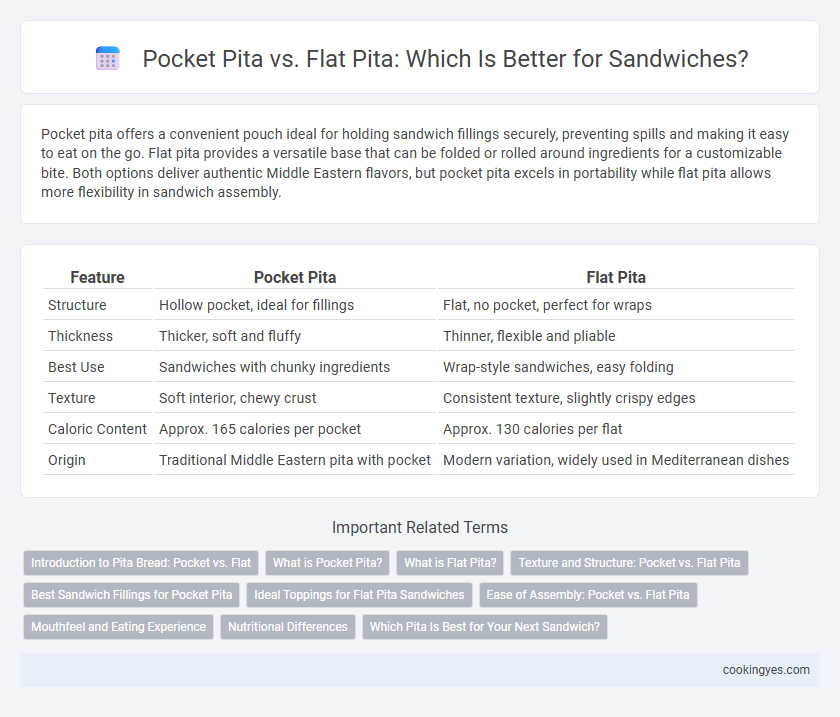Pocket pita offers a convenient pouch ideal for holding sandwich fillings securely, preventing spills and making it easy to eat on the go. Flat pita provides a versatile base that can be folded or rolled around ingredients for a customizable bite. Both options deliver authentic Middle Eastern flavors, but pocket pita excels in portability while flat pita allows more flexibility in sandwich assembly.
Table of Comparison
| Feature | Pocket Pita | Flat Pita |
|---|---|---|
| Structure | Hollow pocket, ideal for fillings | Flat, no pocket, perfect for wraps |
| Thickness | Thicker, soft and fluffy | Thinner, flexible and pliable |
| Best Use | Sandwiches with chunky ingredients | Wrap-style sandwiches, easy folding |
| Texture | Soft interior, chewy crust | Consistent texture, slightly crispy edges |
| Caloric Content | Approx. 165 calories per pocket | Approx. 130 calories per flat |
| Origin | Traditional Middle Eastern pita with pocket | Modern variation, widely used in Mediterranean dishes |
Introduction to Pita Bread: Pocket vs. Flat
Pita bread comes in two main varieties: pocket pita and flat pita, each offering unique benefits for sandwiches. Pocket pita features a hollow interior that conveniently holds fillings, making it ideal for handheld sandwiches and wraps. Flat pita lacks this pocket, providing a versatile, foldable base commonly used for open-faced sandwiches and dipping.
What is Pocket Pita?
Pocket pita is a type of Middle Eastern flatbread characterized by its unique pocket-like cavity formed during baking, making it ideal for stuffing with various sandwich fillings. Unlike flat pita, which remains fully flat and is often used for dipping or wraps, pocket pita's hollow interior securely holds ingredients such as falafel, shawarma, or grilled vegetables. This structural difference enhances its functionality for portable, mess-free sandwiches while maintaining the soft, chewy texture typical of traditional pita bread.
What is Flat Pita?
Flat pita is a soft, round, and thin Middle Eastern bread without a pocket, often used as a wrap or base for sandwiches. Unlike pocket pita, flat pita lacks an inner cavity, making it ideal for folding around fillings or layering with ingredients. Its flexible texture allows for versatile sandwich preparation, accommodating a variety of fresh vegetables, meats, and sauces.
Texture and Structure: Pocket vs. Flat Pita
Pocket pita features a hollow, pocket-like structure that holds sandwich fillings securely, offering a soft and chewy texture that enhances eating convenience. Flat pita has a denser, uniformly flat texture ideal for wrapping or folding, providing a sturdier base but less containment for loose ingredients. Both types deliver unique tactile experiences, with pocket pita favored for mess-free sandwiches and flat pita preferred for versatile, handheld wraps.
Best Sandwich Fillings for Pocket Pita
Pocket pita offers a convenient, self-contained structure ideal for holding juicy, layered fillings such as grilled chicken, falafel, and fresh vegetables without spilling. Its pocket design traps sauces like tzatziki or hummus, enhancing moisture and flavor retention compared to flat pita. For hearty and mess-free sandwiches, pocket pita is best paired with robust fillings like gyro meat, tabbouleh, and roasted eggplant.
Ideal Toppings for Flat Pita Sandwiches
Flat pita sandwiches are ideal for fillings that require even distribution and easy access, such as grilled vegetables, falafel, or chicken shawarma. Toppings like hummus, tabbouleh, cucumbers, and tzatziki complement the flat pita's broad surface, allowing for vibrant, colorful, and textured layers. Unlike pocket pita, flat pita supports open-faced combinations that highlight fresh herbs, olives, and crumbled feta cheese perfectly.
Ease of Assembly: Pocket vs. Flat Pita
Pocket pita offers superior ease of assembly for sandwiches due to its built-in cavity that securely holds fillings without spillage, making it ideal for on-the-go eating. Flat pita requires careful folding to prevent ingredients from falling out, which can complicate preparation and reduce convenience. Therefore, pocket pita enhances sandwich assembly efficiency with its naturally compartmentalized structure.
Mouthfeel and Eating Experience
Pocket pita offers a unique mouthfeel with its soft, hollow interior that holds fillings securely, creating a delightful contrast between the tender bread and crisp ingredients. Flat pita provides a more uniform texture, allowing for an open-faced sandwich experience that emphasizes the chewiness of the bread and the freshness of toppings. Choosing between pocket and flat pita influences the overall eating experience by altering texture dynamics and how flavors are combined during each bite.
Nutritional Differences
Pocket pita and flat pita differ nutritionally, with pocket pita typically containing slightly more calories and carbohydrates due to its thicker, air-pocket structure. Flat pita often has a lower calorie density and reduced carbohydrate content, making it a lighter choice for sandwiches. Both types provide essential nutrients like protein and fiber but vary in serving size and texture, impacting their overall nutritional profile.
Which Pita Is Best for Your Next Sandwich?
Pocket pita offers a convenient structure, creating a natural pocket that holds fillings securely, making it ideal for messy or layered sandwiches. Flat pita provides a versatile, foldable base that accommodates diverse ingredients without containment, perfect for open-faced or rolled sandwiches. Choosing between pocket and flat pita depends on the sandwich style and filling preference, with pocket pita excelling in portability and flat pita offering flexibility.
Pocket pita vs Flat pita for sandwiches Infographic

 cookingyes.com
cookingyes.com